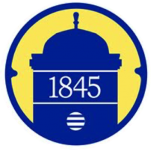Limestone College
South Carolina
1845



Intercollegiate Bureau of Academic Costume lists from 1927 and 1948 described Limestone College’s hood lining as gold with a (single) white chevron, but because this was a duplication of the hood lining the IBAC had already assigned Mills College between 1895 and 1902, the Bureau’s citation for Limestone was probably nothing more than a record of the college’s colors applied to a generic (unofficial) hood lining. An official assignment was likely made in the late 1940s or 1950s because lists compiled by Kevin Sheard in Academic Heraldry in America (1962) and Academic Dress and Insignia of the World (1970) described Limestone’s hood lining as “light gold” with two white chevrons. The Bureau probably used “light gold” as a way to distinguish Limestone’s hood lining from the pattern the IBAC had already assigned the College of Mount Saint Vincent in New York and Shorter College in Georgia (both gold with two white chevrons).
But Limestone’s actual school color was a bright gold, not light gold. So the IBAC looked the other way and in a 1972 list it cited all three colleges as having a gold hood lining with two white chevrons. To avoid this confusing duplication, here Limestone’s hood lining has been modified: blue has been added to the space between the two white chevrons to create what the Bureau called a “tri-chevron”.



Limestone College students adopted gold and white as their school colors in 1899. According to Our College Colors (1949) by Henry L. Snyder, the students chose these colors because white symbolized purity and gold symbolized “true worth”. The school flower is the daisy, which has the same colors and grows all over the campus.
Gold and white began to be used with a third color of blue, and later the school colors of gold and white were replaced by gold and blue. This official substitution may have occurred in the early 1970s after the college became coeducational in the late 1960s, but exactly when and how this happened is not yet known.
Citations in the World Almanac (listed by cover date; color information is from the previous year): yellow/white (1934-1935)
The chevron was by far the most common heraldic division the Intercollegiate Bureau of Academic Costume (IBAC) employed to divide the two or three colors in an institution’s hood, but beginning in 1895 the “double chevron” was also used quite frequently. The typical width of a normal chevron was between three and four inches, but the double chevron pattern used two chevrons of about 1½ inches in width placed approximately two inches apart so that the color of the hood lining showed between them.
